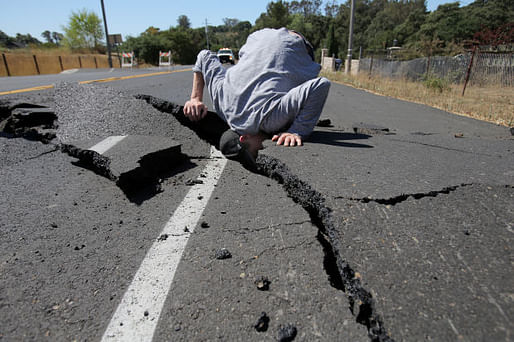

Most of the Bay Area roads, bridges, water systems, dams and levees fared well in Sunday's 6.0 earthquake near Napa, but the damage in the picturesque Wine Country town was a jolting reminder of the vulnerability of public services for 7 million people. A Big One -- such as a 7.0 earthquake on the Hayward Fault that runs beneath heavily populated Oakland and Berkeley -- would inflict more damage to key infrastructure, experts said. — San Jose Mercury News
Overall, the damage caused by the Napa earthquake could have been a lot worse. But a Los Angeles Times article documenting how even retrofitted historic buildings were damaged showcases the profound vulnerability of older structures in California. According to the article: "The destruction highlights one of the greatest fears of seismic engineers — that the retrofitting of unreinforced masonry buildings still leaves weak joints between bricks." Just yesterday, another LA Times article claimed that thousands of brick buildings across the state have not been retrofitted, disproportionately in low-income areas. And while low-cost retrofitting certainly mitigates the risk of a building "pancaking," but doesn't preclude other potential dangers like falling bricks or collapsed walls. Additionally, commentators are pointing to the Napa earthquake as a "wake-up call" to officials that the state's aging infrastructure is in desperate need of an upgrade. For example, a Forbes article detailed that nearly 35 million people drive over dangerously vulnerable bridges in Los Angeles every day. But California is notoriously broke and Emir Macari, a member of the state Seismic Safety Commission and a professor at Cal State University Sacramento, is quoted saying that statewide regulations would end up being "a huge economic loss for the state."
Check out the dangerous bridges near you with this useful map: http://saveourbridges.com/new/map.php
1 Comment
What are the economics that preclude safe and effective infrastructure to be put in place when the lack of such infrastructure will completely destroy the actual economy that makes real stuffs? The state is broke, yet they've had a GDP ranked in the top 10 in the world for the last 40 years? You don't have to be a rocket doctor to see something stinks here, yet no one can call out a cause, or even discuss it. Sounds almost like global warming, the cause, although nice to pin down, doesn't solve the problem, but we're so busy arguing the cause that we can't get to the point of making changes in our own sphere of influence to would help stem the tide. (maybe) Of course changing priorities in Sacramento is the solution, but the cancers and parasites that have hijacked the state won't go without a fight. I see the idea of politically splitting CA into several states of being a more likely end than actually solving the problem and fixing things. (Could be physically as well, wouldn't that be something?)
Block this user
Are you sure you want to block this user and hide all related comments throughout the site?
Archinect
This is your first comment on Archinect. Your comment will be visible once approved.